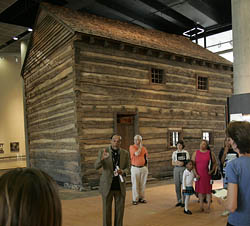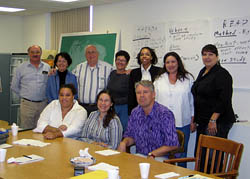Other Laws, Policies and Executive Orders
National Underground Railroad Network to Freedom Act of 1998, Public Law 105-203
“The purposes of this Act are the following:
- To recognize the importance of the Underground Railroad, the sacrifices made by those who used the Underground Railroad in search of freedom from tyranny and oppression, and the sacrifices made by the people who helped them.
- To authorize the National Park Service to coordinate and facilitate Federal and non-Federal activities to commemorate, honor, and interpret the history of the Underground Railroad, its significance as a crucial element in the evolution of the national civil rights movement, and its relevance in fostering the spirit of racial harmony and national reconciliation.”
The National Park Service is implementing a National Underground Railroad Program to coordinate preservation and education efforts nationwide and integrate local historical places, museums, and interpretive programs associated with the Underground Railroad into a mosaic of community, regional, and national stories. The NPS project builds upon and is supported by community initiatives around the country as well as legislation passed in 1990 and the National Underground Railroad Network to Freedom Act of 1998.
One national and seven regional coordinators administer and coordinate the Network, one of whom was formerly a member of the Park Ethnography Program. Ethnographers from the Park Ethnography Program participate in the Network “Gatherings” of community stakeholders in the project, acting as discussion leaders or facilitators. Visit the NPS National Underground Railroad Network to Freedom web site to learn more about this initiative.
The National Underground Railroad Freedom Center is one of the partner organizations working with the National Park Service. The Freedom Center, founded in 1995 as a non-profit organization to interpret the history of the Underground Railroad, opened in 2004 as a national cultural center in Cincinnati, Ohio.
The National Underground Railroad Freedom Center teaches how to understand freedom in our daily lives. In 2004, the Freedom Center opened its 158,000-square-foot, $110-million complex. The complex houses a performance theater, hall for multicultural dialogue, six highly interactive history exhibit galleries, and an education and research center; it also serves as headquarters for a national network of Freedom Station affiliates. Visit the National Underground Railroad Freedom Center web site to learn more about this initiative.
American Battlefield Protection Act of 1996
This Act became law on November 12, 1996 (Public Law 104-333, 16 U.S.C. 469k). It has not been amended and, unless renewed, the Law will sunset in 2006.
“The purpose of this section is to assist citizens, public and private institutions, and governments at all levels in planning, interpreting, and protecting sites where historic battles were fought on American soil during the armed conflicts that shaped the growth and development of the United States, in order that present and future generations may learn and gain inspiration from the ground where Americans made their ultimate sacrifice.”
The Program authorizes the established national historic preservation program to provide the preservation assistance that shall encourage, support, assist, recognize, and work in partnership with citizens, federal, state, local, and tribal governments, other public entities, educational institutions, and private nonprofit organizations in identifying, researching, evaluating, interpreting, and protecting historic battlefields and associated sites on a national, state, and local level.
Executive Order 13287 Preserve America signed by President George Bush, 2004
Executive Order 13287 Preserve America extends the NHPA provisions in ways that promote greater use of historical sites in partnership with State, Tribal, and local governments for purposes of heritage tourism and economic development. The initiative promotes public-private partnerships that enhance historic and cultural preservation encouraging public participation and appreciation of the nation’s cultural patrimony (Matthews 2005).
Like other federal programs in the Park Service, Park Ethnography has a responsibility under this Executive Order for inventory of ethnographic resources and participating in partnerships for purposes of promoting heritage tourism and economic development. To this end in 2004, the Ethnography Program sponsored a training-planning workshop and ethnographic research project.
The Tourism Impact Study Workshop and Rapid Ethnographic Research Project was developed and implemented in partnership with the El Camino Real de Tierra Adentro National Historic Trail administrators from the NPS and the Bureau of Land Management, the International Office of Mexico Affairs, two American Indian pueblos, Hispanic American community representatives, faculty and student representatives of three university departments of Anthropology, the Spanish Colonial Research Center, NPS and the National Institute of Anthropology and History of the United Mexican States (Nacional de Centros, Instituto Nacional de Antropología e Historia). Three workshops were held in 2004, the first to train participants in Rapid Ethnographic Assessment and to do initial planning. Subsequently, park ethnographers held two smaller workshops with representatives of each of the pueblos and local Hispanic American community representatives to plan ethnographic research focusing on the impact of heritage tourism, including the Trail’s potential for improving local economies.
The Secretary of the Interior’s Standards and Guidelines for Federal Agency Historic Preservation Programs Pursuant to the National Historic Preservation Act. (Published in Final Federal Register 24 April 1998)
Section 110 of the National Historic Preservation Act (hereinafter referred to as NHPA or the Act) sets out the broad historic preservation responsibilities of federal agencies and is intended to ensure that historic preservation is fully integrated into the ongoing programs of all federal agencies. The broad purposes of the Section are to:
- expand and make more explicit the NHPA statute’s statement of federal agency responsibility for identifying and protecting historic properties and avoiding unnecessary damage to them,
- charge each federal agency with the affirmative responsibility for considering projects and programs that further the purposes of the NHPA, and
- declare the costs of preservation activities eligible project costs in all undertakings conducted or assisted by a federal agency.
The Secretary’s Guidelines influence Heritage Preservation Services more than they affect Park Ethnographers.
Heritage Preservation Laws, Policies, and Executive Orders created the need for the Park Ethnography Program and over time affected the ethnographers’ roles and spheres of influence in the National Park System. The next section describes the park ethnographers' roles and spheres of influence.







